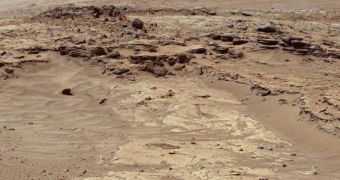Officials with the NASA Jet Propulsion Laboratory (JPL) in Pasadena, California have recently announced that the Mars Science Laboratory (MSL) rover Curiosity will soon begin investigating for a new window into the Red Planet's distant geological past. This may be achieved through studies of cement grains holding together limestone rocks in a landscape feature called Kimberly.
The explorations robot arrived at this location just a few days ago, but its cameras have already returned numerous images of the surrounding area. What researchers are seeing are multiple types of limestones in the same place, even though most of these materials look as if they are identical.
The thing that first fascinated mission controllers about Kimberly is the fact that it represents a crossroads where four different types of rock textures intersect. This was first discovered in images collected from orbit by the NASA Mars Reconnaissance Orbiter (MRO). What is even more interesting is that most of the rocks in Kimberly are held together by a type of grainy cement-like material.
The upcoming investigations will represent the first time Curiosity switches from studying mudstone to sandstone. Thus far, during its studies of a landscape feature called Yellowknife Bay, the rover was able to discover evidences of an ancient Martian lakebed, which appears to have been favorable to the development of basic lifeforms.
“The orbital images didn't tell us what those rocks are, but now that Curiosity is getting closer, we're seeing a preview. The contrasting textures and durabilities of sandstones in this area are fascinating. While superficially similar, the rocks likely formed and evolved quite differently from each other,” says JPL researcher Ashwin Vasavada, who is a deputy project scientist for Curiosity.
The waypoint where the mission is scheduled to stop for more in-depth studies is currently located around 86 meters (282 feet) away from the rover. Experts plan to use Curiosity's drill instrument to collect some samples for analysis inside the rover's internal ovens. These instruments can break down any material into its constituent chemicals.
Scientists explain that what they are particularly interested in is the cement found in sandstones, which is basically the material that fills up the space between grains of sand in these types of rocks. Depending on how the sandstones formed, the chemical composition of the cement varies. Studying this material will help reveal the different characteristics of eerily-similar rocks on Mars.
“A major issue for us now is to understand why some rocks resist erosion more than other rocks, especially when they are so close to each other and are both likely to be sandstones,” explains the principal investigator for the Mast Camera and the Mars Descent Camera on Curiosity, Michael Malin, from Malin Space Science Systems in San Diego.

 14 DAY TRIAL //
14 DAY TRIAL //